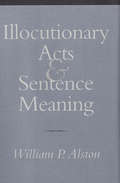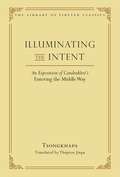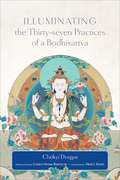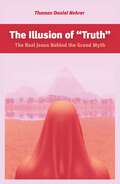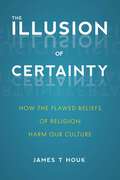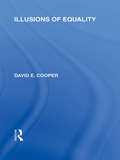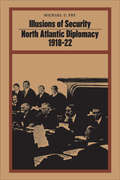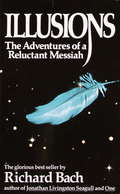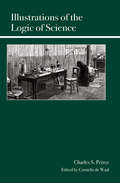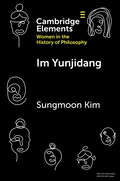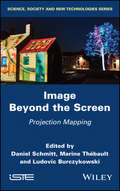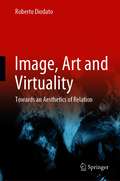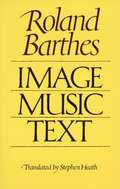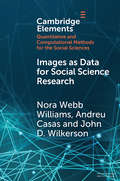- Table View
- List View
Illocutionary Acts and Sentence Meaning
by William P. AlstonWhat is it for a sentence to have a certain meaning? This is the question that the distinguished analytic philosopher William P. Alston addresses in this major contribution to the philosophy of language. His answer focuses on the given sentence's potential to play the role that its speaker had in mind, what he terms the usability of the sentence to perform the illocutionary act intended by its speaker. Alston defines an illocutionary act as an act of saying something with a certain "content." He develops his account of what it is to perform such acts in terms of taking responsibility, in uttering a sentence, for the existence of certain conditions. In requesting someone to open a window, for example, the speaker takes responsibility for its being the case that the window is closed and that the speaker has an interest in its being opened. In Illocutionary Acts and Sentence Meaning, Alston expands upon this concept, creating a framework of five categories of illocutionary act and going on to argue that sentence meaning is fundamentally a matter of illocutionary act potential; that is, for a sentence to have a particular meaning is for it to be usable to perform illocutionary acts of a certain type. In providing detailed and explicit patterns of analysis for the whole range of illocutionary acts, Alston makes a unique contribution to the field of philosophy of language--one that is likely to generate debate for years to come.
Illuminating Errors: New Essays on Knowledge from Non-Knowledge (Routledge Studies in Epistemology)
by Rodrigo Borges Ian SchneeThis is the first collection of essays exclusively devoted to knowledge from non-knowledge and related issues. It features original contributions from some of the most prominent and up-and-coming scholars working in contemporary epistemology. There is a nascent literature in epistemology about the possibility of inferential knowledge based on premises that are, for one reason or another, not known. The essays in this book explore if and how epistemology can accommodate cases where knowledge is generated from something other than knowledge. Can reasoning from false beliefs generate knowledge? Can reasoning from unjustified beliefs generate knowledge? Can reasoning from gettiered beliefs generate knowledge? Can reasoning from propositions one does not even believe generate knowledge? The contributors to this book tackle these and other questions head-on. Together, they advance the debate about knowledge from non-knowledge in novel and interesting directions. Illuminating Errors will be of interest to researchers and advanced students working in epistemology and philosophy of mind.
Illuminating Errors: New Essays on Knowledge from Non-Knowledge (Routledge Studies in Epistemology)
by Rodrigo Borges Ian SchneeThis is the first collection of essays exclusively devoted to knowledge from non-knowledge and related issues. It features original contributions from some of the most prominent and up-and-coming scholars working in contemporary epistemology.There is a nascent literature in epistemology about the possibility of inferential knowledge based on premises that are, for one reason or another, not known. The essays in this book explore if and how epistemology can accommodate cases where knowledge is generated from something other than knowledge. Can reasoning from false beliefs generate knowledge? Can reasoning from unjustified beliefs generate knowledge? Can reasoning from gettiered beliefs generate knowledge? Can reasoning from propositions one does not even believe generate knowledge? The contributors to this book tackle these and other questions head-on. Together, they advance the debate about knowledge from non-knowledge in novel and interesting directions. Illuminating Errors will be of interest to researchers and advanced students working in epistemology and philosophy of mind.
Illuminating the Intent: An Exposition of Candrakirti's Entering the Middle Way (Library of Tibetan Classics #19)
by Thupten JinpaThe Dalai Lama&’s translator and author of the definitive biography of Tsongkhapa here presents the first translation of one of that master&’s seminal and best-known works.This work is perhaps the most influential explanation of Candrakirti&’s seventh-century classic Entering the Middle Way (Madhyamakavatara). Written as a supplement to Nagarjuna&’s Fundamental Verses on the Middle Way, Candrakirti&’s text integrates the central insight of Nagarjuna&’s thought—the rejection of any metaphysical notion of intrinsic existence—with the well-known Mahayana framework of the ten levels of the bodhisattva, and it became the most studied presentation of Madhyamaka thought in Tibet. Completed the year before the author&’s death, Tsongkhapa&’s exposition of Candrakirti&’s text is recognized by the Tibetan tradition as the final standpoint of Tsongkhapa on many philosophical questions, particularly the clear distinctions it draws between the standpoints of the Madhyamaka and Cittamatra schools. Written in exemplary Tibetan, Tsongkhapa&’s work presents a wonderful marriage of rigorous Madhyamaka philosophical analysis with a detailed and subtle account of the progressively advancing mental states and spiritual maturity realized by sincere Madhyamaka practitioners. The work remains the principal textbook for the study of Indian Madhyamaka philosophy in many Tibetan monastic colleges, and it is a principal source for many Tibetan teachers seeking to convey the intricacies of Madhyamaka philosophy to non-Tibetan audiences. Though it is often cited and well known, this is the first full translation of this key work in a Western language.
Illuminating the Thirty-Seven Practices of a Bodhisattva
by Chokyi Nyima Rinpoche Chokyi Dragpa Heidi I. KopplA unique presentation of the Buddhist path by Chökyi Dragpa, the foremost Gelug disciple of the famed nineteenth-century Tibetan master Patrul Rinpoche.Illuminating the Thirty-Seven Practices of a Bodhisattva's quotations and direct instructions from realized sages of the past reinforce one another, subtly penetrating the mind and preparing it for meditation. This book, while fully accessible to newcomers, is especially powerful for serious, established practitioners. Illuminating the Thirty-Seven Practices of a Bodhisattva was previous published under the title Uniting Wisdom and Compassion.
Illusion and Fetishism in Critical Theory: A study of Nietzsche, Benjamin, Castoriadis and the Situationists (Routledge Studies in Social and Political Thought)
by Vasilis GrolliosThrough the negative dialectics of Theodore Adorno, Illusion and Fetishism in Critical Theory offers an examination of Nietzsche, Benjamin, Castoriadis and the Situationists, who put the concept of illusion at the forefront of their philosophical thought. Vasilis Grollios argues that these political philosophers, except Castoriadis, have up to now been wrongly considered by many scholars to be far from the line of thinking of negative dialectics, Critical Theory and the early Frankfurt School/Open Marxist tradition. He illustrates how these thinkers focused on the illusions of capitalism and attempted to show how capitalism, by its innate rationale, creates social forms that are presented as unavoidable and universal, yet are historically specific and of dubious sustainability. Providing a unique overview of concepts including illusion, totality, fetishization, contradiction, identity thinking and dialectics, Grollios expertly reveals how their understanding of critique can help us open cracks in capitalism and radicalize democratic social practice today. Illusion and Fetishism in Critical Theory is a must read for scholars of political theory and political philosophy, critical theory, the Frankfurt School, sociology and democratic theory.
Illusion of "Truth": The Real Jesus Behind the Grand Myth
by Thomas NehrerThe Illusion of "Truth" is a multifaceted look at Jesus of Nazareth, his message and religions created, not from his insights into reality, but on fantasy and lore concocted about him. Tom Nehrer builds on scholarly research through personal level of consciousness, exposing myths to find the real Yeshua who trod dusty roadways of first-century Judea. Understanding Jesus's Kingdom of Heaven within requires extensive perspective. This book explores: Historical, social, political and traditional settings for Jesus appearance; The mindset of ancients--how superstitious peasants imagined divine manipulation; Modern man's mindset -- how causality is projected not only onto gods, but onto real world forces, luck, chance and fate, all illusory processes; How life really works -- metaphysical connection of Self to Reality, an inner-outer flow; How beliefs create illusions -- masking Reality's flow with shared notions of "Truth" which isn't.; Many caveats to accepting Gospel accounts as reliable reports of any substance; The real life of Jesus -- how the man grew from first-century Jewish thinking to fully visionary status, aware of the Self as driving force in life; The Parables whose rich stories reveal Jesus' awareness of the functional Oneness of Consciousness/Reality; A deeply critical look at Christianity -- its early growth, smothering of alternate explanations and claims to represent true traditions back through the apostles to Jesus. That claim is shown as bogus, when Gospel writers only show apostles as unable to grasp Jesus' Kingdom illustrations. The Illusion of "Truth" reveals not only how life works and how Jesus was fully aware of its meaning-based flow -- but how Christianity grew from ancient notions and layered myth about Jesus, rather than insights from him.
Illusion of Certainty: How the Flawed Beliefs of Religion Harm Our Culture
by James T. HoukIn this examination of religion's influence on society, an anthropologist critiques fundamentalism and all mindsets based on rigid cultural certainties. The author argues that the future can only be safeguarded by a global humanistic outlook that recognizes and respects differing cultural perspectives and endorses the use of critical reason and empiricism. Houk coins the term "culturalism" to describe dogmatic viewpoints governed by culture-specific values and preconceived notions. Culturalism gives rise not only to fundamentalism in religion but also stereotypes about race, gender, and sexual orientation. Turning specifically to Christian fundamentalism, the author analyzes the many weaknesses of what he calls a faith-based epistemology, particularly as such thinking is displayed in young-earth creationism, the reliance on revelation and subjective experiences as a source of religious knowledge, and the reverence accorded the Bible despite its obvious flaws. As he points out, the problem with such cultural knowledge generally is that it is non-falsifiable and ultimately has no lasting value in contrast to the data-based and falsifiable knowledge produced by science, which continues to prove its worth as a reliable source of accurate information. Concluding that there is no future to the fundamentalist mindset in a diverse world where religion often exacerbates conflicts, he makes a strong case for reason and mutual tolerance.
Illusions of Equality (International Library Of The Philosophy Of Education)
by David CooperEducational policy and discussion, in Britain and the USA, are increasingly dominated by the confused ideology of egalitarianism. David E. Cooper begins by identifying the principles hidden among the confusions, and argues that these necessarily conflict with the ideal of educational excellence - in which conflict it is this ideal that must be preserved. He goes on to criticize the use of education as a tool for promoting wider social equality, focussing especially on the muddles surrounding 'equal opportunities', 'social mix' and 'reverse discrimination'. Further chapters criticize the 'new egalitarianism' favoured, on epistemological grounds, by various sociologists of knowledge in recent years and 'cultural egalitarianism' according to which standard criteria of educational value merely reflect parochial and economic interests.
Illusions of Security: North Atlantic Diplomacy 1918-22
by Michael FryThe First World War was in many ways the most formative experience for the western world in the twentieth century. Little if anything of importance escaped its influence. For those who helped shape foreign and deference policies in Britain, the United States, and Canada, the war and the consequent peacemaking raised perplexing political, ideological, and racial problems. In their search for solutions, some among the anglophone elites of these three countries arrived at the idea of Atlanticism. To them it seemed possible that the British empire and the United States, the core of the victorious allied coalition, could create a global hegemony, an amended version of the Pax Britannica, which might provide a panacea for the ills of the postwar world. As their views became known, the Atlanticists met with some enthusiasm and much outright hostility. Deliberations for and against Atlanticism focused on renewal of the Anglo-Japanese alliance and on two vital postwar conferences, the Imperial Conference of 1921 and the Washington Conference of 1921-2. Initial prospects for Atlanticism seemed encouraging, but hopes were dashed in real political issues of war debts and European recovery by the end of 1922. The Atlanticist thesis languished and despite periods of co-operation it never regained its appeal throughout the interwar years. Michael Fry relates in fascinating detail the history of these deliberations and of the statesmen who worked for and against Atlanticism. His study sheds light on the evolution of foreign policy in Britain, the dominions, and the United States, and yields insights into relations between these governments during an important time in history.
Illusions: The Adventures of a Reluctant Messiah
by Richard BachIn the cloud-washed airspace between the cornfields of Illinois and blue infinity, a man puts his faith in the propeller of his biplane. For disillusioned writer and itinerant barnstormer Richard Bach, belief is as real as a full tank of gas and sparks firing in the cylinders...until he meets Donald Shimoda--former mechanic and self-described messiah who can make wrenches fly and Richard's imagination soar....In Illusions, the unforgettable follow-up to his phenomenal bestseller Jonathan Livingston Seagull, Richard Bach takes to the air to discover the ageless truths that give our souls wings: that people don't need airplanes to soar...that even the darkest clouds have meaning once we lift ourselves above them... and that messiahs can be found in the unlikeliest places--like hay fields, one-traffic-light midwestern towns, and most of all, deep within ourselves.
Illustrations of the Logic of Science
by Cornelis De Waal Charles Sanders PeirceCharles Peirce's Illustrations of the Logic of Science is an early work in the philosophy of science and the official birthplace of pragmatism. It contains Peirce's two most influential papers: "The Fixation of Belief" and "How to Make Our Ideas Clear," as well as discussions on the theory of probability, the ground of induction, the relation between science and religion, and the logic of abduction. Unsatisfied with the result and driven by a constant, almost feverish urge to improve his work, Peirce spent considerable time and effort revising these papers. After the turn of the century these efforts gained significant momentum when Peirce sought to establish his role in the development of pragmatism while distancing himself from the more popular versions that had become current. The present edition brings together the original series as it appeared in Popular Science Monthly and a selection of Peirce's later revisions, many of which remained hidden in the mass of messy manuscripts that were left behind after his death in 1914.
Iluminaciones: Iluminaciones I (Taurus Humanidades Ser. #Vol. 314)
by Walter BenjaminLa primera selección de textos esenciales de Walter Benjamin. Esta es la primera selección que se publica en España de los textos fundamentales de Walter Benjamin, escogidos cuidadosamente a partir de los cuatro volúmenes de Iluminaciones y el de Discursos interrumpidos. Benjamin fue uno de los críticos culturales más originales e indispensables del siglo XX. Este libro incluye, entre otras reflexiones, las que dedica a Kafka, a quien le unía una estrecha afinidad personal, sus estudios sobre Baudelaire, Proust y Brecht, así como su ingenioso (y emblemático) texto «La obra del arte en la era de su reproductibilidad técnica», una discusión esclarecedora de la traducción como modo literario y sus tesis sobre la filosofía de la historia. ------------- radical: adj. Perteneciente o relativo a la raíz. «Clásicos Radicales» nace con la misión de recuperar algunos de los libros más emblemáticos del sello que en su día formularon una idea nueva u ofrecieron una mirada original y pertinente sobre las grandes cuestiones universales. Ausentes de las librerías durante demasiado tiempo pero recordados y buscados por los lectores más despiertos, estos textos esenciales de disciplinas como la filosofía, la ética, la historia, la sociología, la economía, la antropología, la psicología y la política mantienen su plena vigencia y vuelven hoy con fuerza para iluminar nuestro presente. ------------- Críticas:«Benjamin fue uno de los grandes escritores europeos de este siglo.»Philip Toynbee, The Observer «Su método característico entrar en un tema en ángulo, avanzar paso a paso de una recapitulación perfectamente lograda a la siguiente es tan instantáneamente reconocible como inimitable, ya que requiere un agudo intelecto, un aprendizaje ligeramente gastado, y un estilo de prosa que, una vez que dejó de pensar en sí mismo como el doctor Benjamin, se convirtió en una maravilla de precisión y concisión.»J.M. Coetzee «Benjamin explicó la modernidad con una autoridad que ni cincuenta años de cambios imprevisibles ha debilitado.»Frank Kermode, The New York Review of Books
Iluminación Espiritualmente Incorrecta
by Jed Mckenna Liliana B. GandugliaLA MARCA DE UN VERDADERO MAESTRO es que sabe expresar un tema de suprema complejidad con una simplicidad fuera de serie. Jed McKenna es un maestro, e iluminado espiritual en el tema. Su primer libro, Spiritual Enlightenmen: TheDamedest Thing, fue un clásico instantáneo y lo ubicó como un maestro espiritual de una profundidad y claridad sorprendentes. Ahora su segundo libro, “Iluminación Espiritualmente Incorrecta”, nos invita a un recorrido fascinante del estado de iluminación –lo qué es y lo qué no es, quién está allí, y quién no, cómo llegar allí y como ser un poco mejor. Abundan deliciosas sorpresas, incluyendo el descubrimiento dramático de quizás la más grande de las obras de arte espirituales de todos los tiempos –escondida desde hace tiempo de la simple vista y bien conocida por todos. Whitman, Melville, Thoreau, Mark Twain y U.G. Krishnamurti todos aparecen, y un alumno del primer libro regresa a compartir sus diarios de Autoanálisis Espiritual. También son sorprendentes los esfuerzos amables del autor para guiar al lector desde la iluminación hacia un estado más deseable y accesible. Fracasas al buscarme al principio, mantente valiente, No me encuentras en un lugar, busca en otro, Estoy en algún lugar detenido, esperando por ti -Walt Whitman- Los libros de Jed Mc Kenna no son para todos. Son para las personas que están cansadas de la calesita espiritual y están preparadas para confrontar la cruda realidad con el proceso de concientización. Si te gustan los maestros con todo ese tipo de guarniciones y adornos, Jed no es indicado para ti, pero cuando estés listo para bajarte del carrusel y comenzar tu viaje, Jed McKenna es el tipo indicado para ver – allí, esperando por ti.
Im Yunjidang (Elements on Women in the History of Philosophy)
by Sungmoon KimThis Element aims to critically examine the philosophical thought of Im Yunjidang 任允摯堂 (1721–93), a female Korean Neo-Confucian philosopher from the Chosŏn 朝鮮 dynasty (1392–1910), and to present her as a feminist thinker. Unlike most Korean women of her time, Yunjidang had the exceptional opportunity to be introduced to a major philosophical debate among Korean Neo-Confucians, which was focused on two core questions-whether sages and commoners share the same heart-mind, and whether the natures of human beings and animals are identical. In the course of engaging in this debate, she was able to reformulate Neo-Confucian metaphysics and ethics of moral self-cultivation, culminating in her bold ideas of the moral equality between men and women and the possibility of female sagehood. By proposing a 'stage-approach' to feminism that is also sensitive to the cultural context, this Element shows that Yunjidang's philosophical thought could be best captured in terms of Confucian feminism.
Image Beyond the Screen: Projection Mapping
by Daniel Schmitt Marine Thébault Ludovic BurczykowskiVideomapping with its use of digital images is an audiovisual format that has gained traction with the creative industries. It consists of projecting images onto diverse surfaces, according to their geometric characteristics. It is also synonymous with spatial augmented reality, projection mapping and spatial correspondence. Image Beyond the Screen lays the foundations for a field of interdisciplinary study, encompassing the audiovisual, humanities, and digital creation and technologies. It brings together contributions from researchers, and testimonials from some of the creators, technicians and organizers who now make up the many-faceted community of videomapping. Live entertainment, museum, urban or event planning, cultural heritage, marketing, industry and the medical field are just a few examples of the applications of this media.
Image Science: Iconology, Visual Culture, and Media Aesthetics
by W.J.T. MitchellAlmost thirty years ago, W. J. T. Mitchell's Iconology helped launch the interdisciplinary study of visual media, now a central feature of the humanities. Along with his subsequent Picture Theory and What Do Pictures Want?, Mitchell's now-classic work introduced such ideas as the pictorial turn, the image/picture distinction, the metapicture, and the biopicture. These key concepts imply an approach to images as true objects of investigation--an "image science. " Continuing with this influential line of thought, Image Science gathers Mitchell's most recent essays on media aesthetics, visual culture, and artistic symbolism. The chapters delve into such topics as the physics and biology of images, digital photography and realism, architecture and new media, and the occupation of space in contemporary popular uprisings. The book looks both backward at the emergence of iconology as a field and forward toward what might be possible if image science can indeed approach pictures the same way that empirical sciences approach natural phenomena. Essential for those involved with any aspect of visual media, Image Science is a brilliant call for a method of studying images that overcomes the "two-culture split" between the natural and human sciences.
Image and Argument in Plato's Republic (SUNY series in Ancient Greek Philosophy)
by Marina Berzins McCoyAlthough Plato has long been known as a critic of imagination and its limits, Marina Berzins McCoy explores the extent to which images also play an important, positive role in Plato's philosophical argumentation. She begins by examining the poetic educational context in which Plato is writing and then moves on to the main lines of argument and how they depend upon a variety of uses of the imagination, including paradigms, analogies, models, and myths. McCoy takes up the paradoxical nature of such key metaphysical images as the divided line and cave: on the one hand, the cave and divided line explicitly state problems with images and the visible realm. On the other hand, they are themselves images designed to draw the reader to greater intellectual understanding. The author gives a perspectival reading, arguing that the human being is always situated in between the transcendence of being and the limits of human perspective. Images can enhance our capacity to see intellectually as well as to reimagine ourselves vis-à-vis the timeless and eternal. Engaging with a wide range of continental, dramatic, and Anglo-American scholarship on images in Plato, McCoy examines the treatment of comedy, degenerate regimes, the nature of mimesis, the myth of Er, and the nature of Platonic dialogue itself.
Image, Art and Virtuality: Towards an Aesthetics of Relation
by Roberto DiodatoThis book investigates the ontological state of relations in a unique way. Starting with the notion of system, it shows that the system can be understood as a relational structure, and that relations can be assessed within themselves, with no need to transform relations in elements. “Relations” are understood in contrast to “relational property”: without a relation there is no identity, therefore no existence. What allows us to do that without hypostatizing the relation, and without immediately taking it simply as a causal relation, can be better grasped, possibly, in reference to a few entities that make best display of their systemic nature, for example images, works of art, and virtual bodies.This book shows how virtual bodies are ontological hybrids representing a type of entity that has never appeared in the world before. This entity becomes a phenomenon in interactivity and evades the dichotomy between “external” and “internal”; it is neither a cognitive product of the consciousness, nor an image of the mind. The user is well aware of experiencing anotherreality, also in the sense of a paradoxical reduplication of perceptual synthesis. The virtual body-environment is therefore simultaneously external and internal, with virtual bodies-environments to be seen as artificial windows to an intermediary world. In this intermediary world, the space itself is the result of interactivity; the world takes place in the sense or feeling of immersion experienced by the user; and the body, perceived as “other”, takes upon itself the sense of its reality, of its effectiveness, as an imaginary and pathic incision, as a production of desire and emotion, to the point that the feeling of reality conveyed by a virtual environment will rely significantly on how this environment produces emotions in the users.
Image, Music, Text
by Roland Barthes Stephen HeathThese essays, as selected and translated by Stephen Heath, are among the finest writings Barthes ever published on film and photography, and on the phenomena of sound and image. The classic pieces "Introduction to the Structural Analysis of Narrative" and "The Death of the Author" are also included.
Image: Three Inquiries in Technology and Imagination (TRIOS)
by Thomas A. Carlson Mark C. Taylor Mary-Jane RubensteinThe three essays in Image, written by leading philosophers of religion, explore the modern power of the visual at the intersection of the human and the technological. Modern life is steeped in images, image-making, and attempts to control the world through vision. Mastery of images has been advanced by technologies that expand and reshape vision and enable us to create, store, transmit, and display images. The three essays in Image, written by leading philosophers of religion Mark C. Taylor, Mary-Jane Rubenstein, and Thomas A. Carlson, explore the power of the visual at the intersection of the human and the technological. Building on Heidegger’s notion that modern humanity aims to master the world by picturing or representing the real, they investigate the contemporary culture of the image in its philosophical, religious, economic, political, imperial, and military dimensions, challenging the abstraction, anonymity, and dangerous disconnection of contemporary images. Taylor traces a history of capitalism, focusing on its lack of humility, particularly in the face of mortality, and he considers art as a possible way to reconnect us to the earth. Through a genealogy of iconic views from space, Rubenstein exposes the delusions of conquest associated with extraterrestrial travel. Starting with the pressing issues of surveillance capitalism and facial recognition technology, Carlson extends Heidegger’s analysis through a meditation on the telematic elimination of the individual brought about by totalizing technologies. Together, these essays call for a consideration of how we can act responsibly toward the past in a way that preserves the earth for future generations. Attending to the fragility of material things and to our own mortality, they propose new practices of imagination grounded in love and humility.
Images Of The Feminine In Gnosticism (Studies In Antiquity And Christianity)
by Karen L. KingIn this groundbreaking collection of essays, King and other contributors engage in a systematic study of issues of gender in Gnosticism. Using a variety of critical methods, the writers ask questions such as: What is the relationship of gendered images to the real lives of women and men? Did ascetic or libertine practices offer an attractive alternative to women in a patriarchal society? Are the images of strong, female goddesses, saviors, and heroines an indication Gnosticism would have been attractive to women? Is it plausible that women in some gnostic groups were authors, teachers, and leaders? Is it possible that some of the Gnostic texts we possess were written by women? What parts did women play in ritual? Did asceticism or libertinism have a different set of social functions for women than for men? These lucid essays offer significant insights into the cultural context and religious practices of Gnosticism.
Images as Data for Social Science Research: An Introduction to Convolutional Neural Nets for Image Classification (Elements in Quantitative and Computational Methods for the Social Sciences)
by John D. Wilkerson Nora Webb Williams Andreu CasasImages play a crucial role in shaping and reflecting political life. Digitization has vastly increased the presence of such images in daily life, creating valuable new research opportunities for social scientists. We show how recent innovations in computer vision methods can substantially lower the costs of using images as data. We introduce readers to the deep learning algorithms commonly used for object recognition, facial recognition, and visual sentiment analysis. We then provide guidance and specific instructions for scholars interested in using these methods in their own research.
Images of Anarchy
by Ioannis D. EvrigenisHobbes's concept of the natural condition of mankind became an inescapable point of reference for subsequent political thought, shaping the theories of emulators and critics alike, and has had a profound impact on our understanding of human nature, anarchy, and international relations. Yet, despite Hobbes's insistence on precision, the state of nature is an elusive concept. Has it ever existed and, if so, for whom? Hobbes offered several answers to these questions, which taken together reveal a consistent strategy aimed at providing his readers with a possible, probable, and memorable account of the consequences of disobedience. This book examines the development of this powerful image throughout Hobbes's works, and traces its origins in his sources of inspiration. The resulting trajectory of the state of nature illuminates the ways in which Hobbes employed a rhetoric of science and a science of rhetoric in his relentless pursuit of peace.
Images of Class: Operaismo, Autonomia and the Visual Arts (1962-1988)
by Jacopo GalimbertiThe first overview of the unique encounter between artists and the prominent Marxist current Workerism, also known as OperaismoDuring the 1960s and 1970s, Workerism and Autonomia were prominent Marxist currents. However, it is rarely acknowledged that these movements inspired many visual artists such as the members of Archizoom, Gordon Matta-Clark and Gianfranco Baruchello. This book focuses on the aesthetic and cultural discourse developed by three generations of militants (including Mario Tronti, Antonio Negri, Bifo and Silvia Federici), and how it was appropriated by artists, architects, graphic designers and architectural historians such as Manfredo Tafuri. Images of Classsignposts key moments of this dialogue, ranging from the drawings published on classe operaia to Potere Operaio&’s exhibition in Paris, the Metropolitan Indians&’ zines, a feminist art collective who adhered to the Wages for Housework Campaign, and the N group&’s experiments with Gestalt theory. Featuring more than 140 images of artworks, many published here for the first time, this volume provides an original perspective on post-war Italian culture and new insights into some of the most influential Marxist movements of the twentieth and twenty-first centuries worldwide.
